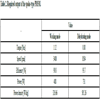- Home
- About Journals
-
Information for Authors/ReviewersEditorial Policies
Publication Fee
Publication Cycle - Process Flowchart
Online Manuscript Submission and Tracking System
Publishing Ethics and Rectitude
Authorship
Author Benefits
Reviewer Guidelines
Guest Editor Guidelines
Peer Review Workflow
Quick Track Option
Copyediting Services
Bentham Open Membership
Bentham Open Advisory Board
Archiving Policies
Fabricating and Stating False Information
Post Publication Discussions and Corrections
Editorial Management
Advertise With Us
Funding Agencies
Rate List
Kudos
General FAQs
Special Fee Waivers and Discounts
- Contact
- Help
- About Us
- Search

The Open Electrical & Electronic Engineering Journal
(Discontinued)
ISSN: 1874-1290 ― Volume 13, 2019
Design of Power Density Improvement by Applying Novel Shape of Slit and Notch to Outer Rib of Rotor of Spoke-type Permanent Magnet Synchronous Motor
Hyungkwan Jang, Sooyoung Cho, Kang Seok Lee, Ye Jun Oh, Ju Lee*
Abstract
Objective:
In this study, improvement of power density by applying novel shape of slit and notch to outer ribs of a rotor that reduces magnetic flux leakage in outer rib and increases air-gap magnetic flux density for spe PMSM for a washing machine, was investigated.
Methods:
It is important that motors for home appliance require lower manufacturing cost, high power and high efficiency. In order to increase power, rotor shape is re-designed. In the outer rib of the rotor, magnetic flux leakage occurs by permanent magnet and magnetic flux is saturated which is one of the factors that reduces the power and efficiency. However, if the outer rib is designed to be too thin, the permanent magnet may scatter during high-speed rotation. Therefore, a design considering permanent magnet scattering is necessary. Motor for a washing machine has two operating points that washing mode at constant torque point and dehydrating mode at high-speed point.
Conclusion:
For improvement of higher power density, 2-D finite elements analysis was performed to optimize the parameters of the shape of slit and notch to increase the torque. The torque increases by optimizing width and length of slit shape and notch shape. Finally, with the optimized parameters of shape of slit and notch, stack length was adjusted as per torque requirement for a washing machine motor and power density increases considering the safe factor from stiffness analysis.
Article Information
Identifiers and Pagination:
Year: 2018Volume: 12
First Page: 75
Last Page: 85
Publisher Id: TOEEJ-12-75
DOI: 10.2174/1874129001812010075
Article History:
Received Date: 2/4/2018Revision Received Date: 8/8/2018
Acceptance Date: 26/9/2018
Electronic publication date: 24/10/2018
Collection year: 2018
open-access license: This is an open access article distributed under the terms of the Creative Commons Attribution 4.0 International Public License (CC-BY 4.0), a copy of which is available at: https://creativecommons.org/licenses/by/4.0/legalcode. This license permits unrestricted use, distribution, and reproduction in any medium, provided the original author and source are credited.
* Address correspondence to this author at the Department of Electrical Engineering, Hanyang University, P.O. Box: 04763, Seoul, South Korea; Tel: +82-2-2220-0342; E-mail: julee@hanyang.ac.kr
| Open Peer Review Details | |||
|---|---|---|---|
| Manuscript submitted on 2-4-2018 |
Original Manuscript | Design of Power Density Improvement by Applying Novel Shape of Slit and Notch to Outer Rib of Rotor of Spoke-type Permanent Magnet Synchronous Motor | |
1. INTRODUCTION
As energy efficiency becomes more important, the use of permanent magnet synchronous motor (PMSM) for home appliances is more increased than conventional induction motors. Induction motors are used widely because of having advantages of low cost and good robustness. However, it has lower efficiency than PMSM [1W. Zhao, T.A. Lipo, and B. Kwon, "Torque pulsation minimization in spoke-type interior permanent magnet motors with skewing and sinusoidal permanent magnet configurations", IEEE Trans. Magn., vol. 51, no. 11, p. 8110804.
[http://dx.doi.org/10.1109/TMAG.2015.2442977] ]. In the recent years, a ferrite permanent PMSM having a high power density has been widely used for home appliance washing machine motors. The washing machine motor has different driving torques and speeds in the washing mode and the dehydrating mode. Therefore, a motor that satisfies both the required torque in the washing mode and dehydrating mode should be designed [2K.Y. Hwang, J.H. Jo, and B.I. Kwon, "A study on optimal pole design of spoke-type IPMSM with concentrated winding for reducing the torque ripple by experiment design method", IEEE Trans. Magn., vol. 45, no. 10, pp. 4712-4715.
[http://dx.doi.org/10.1109/TMAG.2009.2022645] ]. A PMSM is divided into SPMSM and IPMSM categories. For the SPMSM, only magnetic torque is generated by permanent magnets. However, the IPMSM use magnetic torque by permanent magnet and reluctance torque by inductance difference of d-axis and q-axis [3H. Tachibana, M. Sanada, S. Morimoto, and Y. Inoue, "Study on the ratio of outer diameter to stack length suitable for high torque and high power in IPMSMs", 2012 15th International Conference on Electrical Machines and Systems (ICEMS),. Sapporo, Japan, 2012., 4S. Cho, H. Ahn, H.C. Liu, H. Hong, J. Lee, and S. Go, "Analysis of inductance according to the applied current in spoke-type PMSM and suggestion of driving mode", IEEE Trans. Magn., vol. 53, no. 6, p. 8202404.
[http://dx.doi.org/10.1109/TMAG.2017.2662719] ]. IPMSM is used in many industry fields due to the high efficiency and power density [5P. Liang, F. Chai, Y. Li, and Y. Pei, "Analytical prediction of magnetic field distribution in spoke-type permanent-magnet synchronous machines accounting for bridge saturation and magnet shape", IEEE Trans. Ind. Electron, vol. 64, no. 5, pp. 3479-3488.-8R.T. Ugale, and B.N. Chaudhari, "Rotor configurations for improved starting and synchronous performance of line start permanent-magnet synchronous motor", IEEE Trans. Ind. Electron., vol. 64, no. 1, pp. 138-148.
[http://dx.doi.org/10.1109/TIE.2016.2606587] ]. The spoke-type PMSM has a structure in which permanent magnets are inserted into the rotor, and are classified into the IPMSM category [9R.N. Firdaus, R. Suhairi, S. Farina, K.A. Karim, and Z. Ibrahim, "Improvement of power density spoke type permanent magnet generator", 2015 IEEE 11th International Conference on Power Electronics and Drive Systems, .Sydney, NSW, Australia]. Also, it has advantages of using both magnetic torque and reluctance torque. In addition, as the spoke-type PMSM has a magnetic flux concentrating structure, it can improve the power and replace the rare-earth permanent magnets with relatively inexpensive ferrite permanent magnet [10M. Kimiabeigi, J.D. Widmer, R. Long, Y. Gao, J. Goss, R. Martin, T. Lisle, J.M. Vizan, A. Michaelides, and B.C. Mecrow, "On selection of rotor support material for a ferrite magnet spoke-type traction motor", IEEE Trans. Ind. Appl., vol. 52, no. 3, pp. 2224-2233.
[http://dx.doi.org/10.1109/TIA.2016.2530722] ]. From industrial point of view, the methods of reducing the volume of the motor in order to lower the manufacturing cost are actively studied [11H. Seol, T. Jeong, H. Jun, J. Lee, and D. Kang, "Design of 3-times magnetizer and rotor of spoke-type PMSM considering post-assembly magnetization", IEEE Trans. Magn., vol. 53, no. 11, p. 8208005.
[http://dx.doi.org/10.1109/TMAG.2017.2707593] -14A. Tap, L. Xheladini, T. Asan, M. Imeryuz, M. Yilmaz, and L.T. Ergene, "Effects of the rotor design parameters on the torque production of a PMaSynRM for washing machine applications", 2017 International Conference on Optimization of Electrical and Electronic Equipment (OPTIM) & 2017 Intl Aegean Conference on Electrical Machines and Power Electronics (ACEMP), . Brasov, Romania, 2017.]. Even though, the power of ferrite PMSM is lower than the power of rare-earth permanent magnet because of its lower magnetic density, there is no eddy current loss on permanent magnet due to the characteristic of ferrite material, which means to minimize the total loss. The spoke-type PMSM has high harmonics and distortion of air-gap magnetic flux density because the magnetic flux are concentrated to direction of rotating, which generates the back-electromotive force (back-EMF), cogging torque and torque ripple [15H. Nak, M.O. Gulbahce, M. Gokasan, and A.F. Ergenc, "Performance investigation of extended Kalman filter based observer for PMSM using in washing machine applications", 2015 9th International Conference on Electrical and Electronics Engineering (ELECO), .Bursa, Turkey, 16X. Liu, H. Chen, J. Zhao, and A. Belahcen, "Research on the performances and parameters of interior PMSM used for electric vehicles", IEEE Trans. Ind. Electron., vol. 63, no. 6, pp. 3533-3545.
[http://dx.doi.org/10.1109/TIE.2016.2524415] ].
To increase power, it is necessary to modify the shape of the rotor. It can be expected that magnetic flux density transmitting to the air gap can increase by reducing magnetic flux leakage in the ribs. When magnetic flux density transmitting to the air gap should increase [17H. Kim, and J. Moon, "Improved rotor structures for increasing flux per pole of permanent magnet synchronous motor", IET Electr. Power Appl., vol. 12, no. 3, pp. 415-422.
[http://dx.doi.org/10.1049/iet-epa.2017.0432] ], power will increase. Furthermore, there is a method to increase the torque by extending stack length. However, in case of the spoke-type PMSM, there is a case where the torque is not improved with the increase in the axial length due to the axial magnetic flux leakage [12S. Lee, J. Lee, and W. Kim, "A study on correcting the nonlinearity between stack length and back electromotive force in spoke type ferrite magnet motors", IEEE Trans. Magn., vol. 53, no. 6, p. 8201404.
[http://dx.doi.org/10.1109/TMAG.2017.2655059] ].
In this study, the shape of the rotor of the spoke-type PMSM for a washing machine was redesigned to improve the power density by reducing leakage flux using 2-D finite element analysis (FEA). In the section 2, output characteristics and design parameters of basic motor for a washing machine were analyzed. In section 3, the width and length of the slit shape and notch shape were optimized to improve the torque and then satisfy the safe factor during high-speed rotation by stiffness analysis. Finally, the power density increases by reducing the stack length in the final model to meet the required output condition of the washing machine motor.
2. ANALYSIS OF THE SPOKE-TYPE PMSM FOR THE WASHING MACHINE
2.1. Design Conditions and Parameters
Table 1 shows the design condition of the basic model of the spoke-type PMSM for the washing machine. The diameter of rotor is 60% of the diameter of the stator. The coil is 0.8 mm diameter of aluminum and teeth concentrated winding was applied with a fill factor of 0.45.
2.2. Analysis of Required Output Condition and Characteristic of the Basic Model
The washing machine has a gear with a ratio of 11.6:1, as shown in Table 1, connected to the spoke-type PMSM. Table 2 shows the required output condition of the spoke-type PMSM for the washing machine.
On the washing mode, a pulsator of the washing machine rotates at 300 rpm when the spoke-type PMSM rotates at 3480 rpm. For dehydrating mode, a washing machine tub rotates at 740 rpm when the spoke-type PMSM rotates at 8584 rpm. The required torque should be 1.12 Nm for washing mode and 0.80 Nm for dehydrating mode. The back-EMF should not exceed the voltage limit of 161 V by the DC link according to Table 1. Fig. (1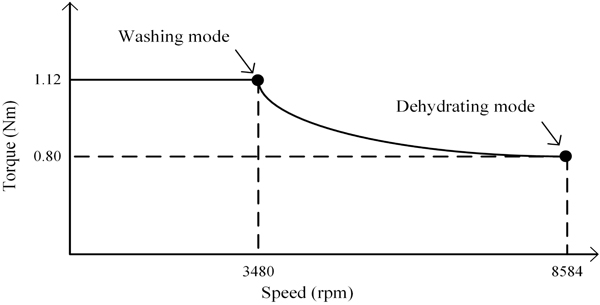 ) shows the torque-speed curve of the constant power characteristic of the basic model.
) shows the torque-speed curve of the constant power characteristic of the basic model.
 |
Fig. (1) Torque and speed curve of spoke-type PMSM for a washing machine. |
In this paper, the stator shape is not modified and the rotor shape is re-designed to reduce the manufacturing cost and improve the power density. Fig. (2a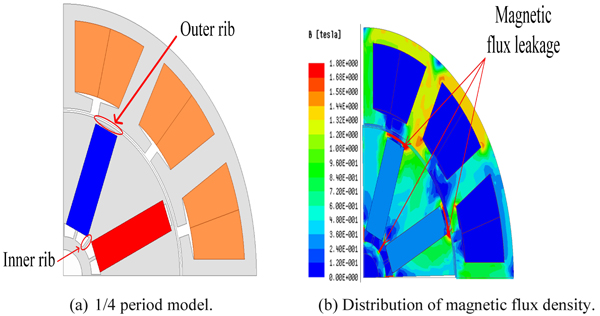 ) presents the basic model and Fig. (2b
) presents the basic model and Fig. (2b ) shows the distribution of magnetic flux density at 3480 rpm. It is well known factor that magnetic flux leakage decreasing the power and the efficiency occurred and saturated on the inner rib and outer rib in shown the Fig. (2b
) shows the distribution of magnetic flux density at 3480 rpm. It is well known factor that magnetic flux leakage decreasing the power and the efficiency occurred and saturated on the inner rib and outer rib in shown the Fig. (2b ). Hence, this is a method of improving the torque by reducing the magnetic flux leakage, while satisfying the rotor stiffness at high-speed.
). Hence, this is a method of improving the torque by reducing the magnetic flux leakage, while satisfying the rotor stiffness at high-speed.
 |
Fig. (2) Basic model of the spoke-type PMSM for a washing machine. |
3. RE-DESIGN OF ROTOR WITH SLIT SHAPE AND NOTCH SHAPE FOR IMPROVEMENT OF POWER DENSITY
3.1. A Method of Applying the Shape of Slit and Notch
Fig. (3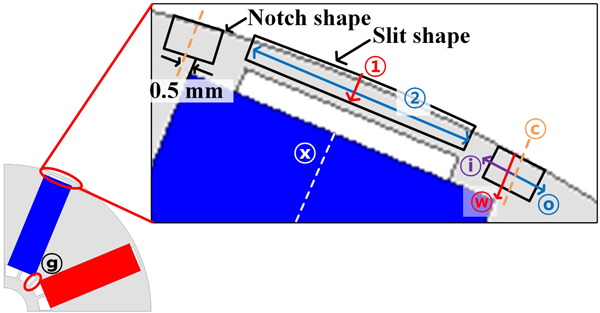 ) shows the parameters of slit shape and notch shape. Parts of re-design are divided into two parts, one is slit shape and another one is notch shape. First, making the groove with the slit shape applied to the outer rib. Second, making the groove of the notch shape at both ends of the permanent magnet with thickness of 5 mm.
) shows the parameters of slit shape and notch shape. Parts of re-design are divided into two parts, one is slit shape and another one is notch shape. First, making the groove with the slit shape applied to the outer rib. Second, making the groove of the notch shape at both ends of the permanent magnet with thickness of 5 mm.
In case of slit shape grooves,  and
and  are the width and length of the slit shape applied to the outer rib portion, respectively. The slit shape width is in the radial direction from the end of the rotor to the center of the rotor. In addition, the slit shape length is on both sides with respect to the center of the permanent magnet. The next step is to make the groove of the notch.
are the width and length of the slit shape applied to the outer rib portion, respectively. The slit shape width is in the radial direction from the end of the rotor to the center of the rotor. In addition, the slit shape length is on both sides with respect to the center of the permanent magnet. The next step is to make the groove of the notch.
 |
Fig. (3) Design variables of the slit shape and the notch shape. |
Shape, so that  is the center of the notch shape and 0.5 mm away from the end of the permanent magnet.
is the center of the notch shape and 0.5 mm away from the end of the permanent magnet.  and
and  denote inner length and outer length of the notch shape, respectively, centered on the center of notch shape.
denote inner length and outer length of the notch shape, respectively, centered on the center of notch shape.  represents the notch shape width from the end of the rotor to the center of the rotor in the radial direction.
represents the notch shape width from the end of the rotor to the center of the rotor in the radial direction.  indicates the inner rib, which is also the area where magnetic flux leakage and magnetic flux density saturation occur.
indicates the inner rib, which is also the area where magnetic flux leakage and magnetic flux density saturation occur.
In order to increase torque, the inner rib of the rotor was partially removed. This is because the torque increases by removing the inner rib, which affects magnetic flux leakage [18X. Ge, Z.Q. Zhu, J. Li, and J. Chen, "A spoke-type IPM machine with novel alternate airspace barriers and reduction of unipolar leakage flux by step-staggered rotor", IEEE Trans. Ind. Appl., vol. 52, no. 6, pp. 4789-4797.
[http://dx.doi.org/10.1109/TIA.2016.2600649] ]. The re-design of the rotor flowchart is shown in Fig. (4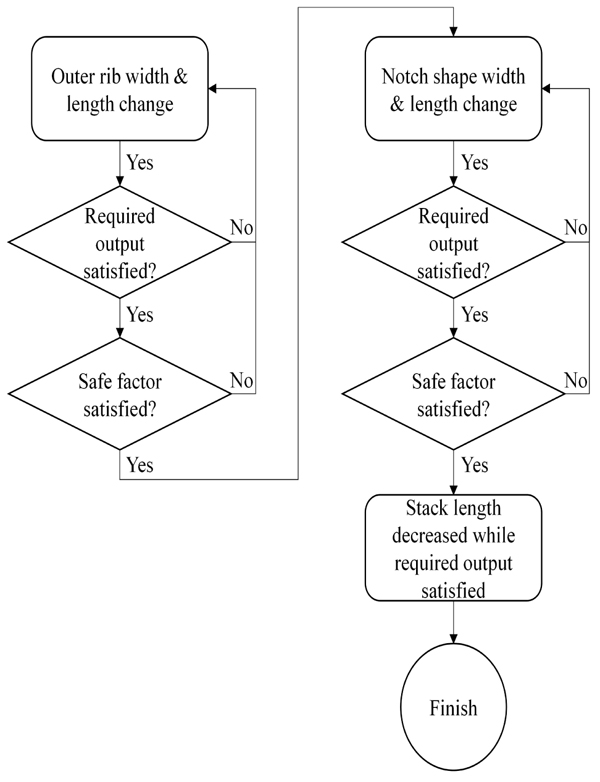 ).
).
 |
Fig. (4) Flow chart of optimizing shape of slit and notch. |
First, we optimize the width and length of the slit shape to improve the torque under the condition that the safe factor is 1.3 or more. Second, the width, inner length, and outer length of the notch shape were optimized when both the safe factor and the torque improvement are satisfied in the same design. In order to improve the power density with the optimized shape of slit and notch, stack length is reduced to meet the required torque and output condition of the spoke-type PMSM for a washing machine. The formula for the safe factor of the motor is expressed in Eq. (1). The ultimate stress of the electric steel sheet used for the washing machine motor is 467 MPa.
 |
(1) |
3.2. Re-Design of the Rotor with Slit Shape and Analysis of the Torque
In order to optimize the slit shape applied to the outer rib portion, optimization was performed for the width of the slit shape at first. For reference, the outer rib width of the base model is 0.5 mm. As stated forehead, the width of the slit shape has the direction that enters the center of the rotor in the radial direction from the end of the rotor. Simulation test was carried out and the torque was obtained by changing the slit shape width from 0 mm to 0.35 mm. In this case, the slit shape length is fixed at 4 mm. Fig. (5a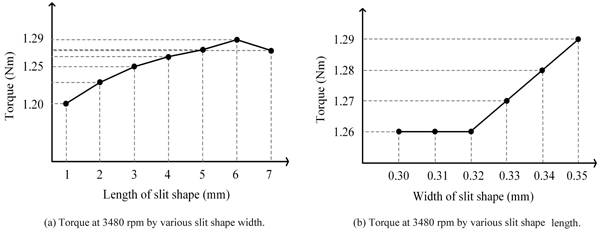 ) shows that the torque at 3480 rpm increases as the slit shape width increases.
) shows that the torque at 3480 rpm increases as the slit shape width increases.
 |
Fig. (5) Torque at 3480rpm by various width and length of slit shape. |
It can be seen that a tendency that the air-gap magnetic flux density transmitted to the air gap increases as the leakage magnetic flux decreases. Fig. (5b ) shows the torque according to the change of the slit shape length with the slit shape width of 0.33 mm optimized in previous step. As the slit shape length increases, the torque increases, but at 7 mm, the torque tends to decrease. The reason is that when the slit shape length is 7 mm, magnetic resistance increases that affect of the magnetic flux transmitted to the air-gap. Therefore, when the slit shape length is 6 mm, the maximum torque can be determined to be 1.29 Nm at 3480 rpm. In Fig. (6
) shows the torque according to the change of the slit shape length with the slit shape width of 0.33 mm optimized in previous step. As the slit shape length increases, the torque increases, but at 7 mm, the torque tends to decrease. The reason is that when the slit shape length is 7 mm, magnetic resistance increases that affect of the magnetic flux transmitted to the air-gap. Therefore, when the slit shape length is 6 mm, the maximum torque can be determined to be 1.29 Nm at 3480 rpm. In Fig. (6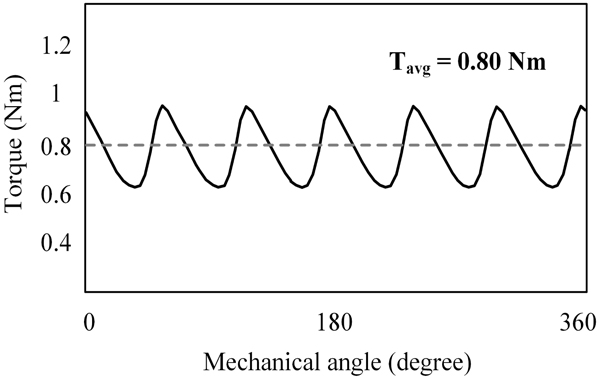 ), the torque on dehydrating mode is 0.80 Nm @ 8584 rpm and the back-EMF is 161.0V, satisfying both the required output conditions.
), the torque on dehydrating mode is 0.80 Nm @ 8584 rpm and the back-EMF is 161.0V, satisfying both the required output conditions.
In the stiffness analysis, maximum stress occurs around the corner of ribs when a rotor is rotating at high speed. Thickness of the ribs should be appropriate thickness that the permanent magnet is prevented from scattering. Considering the safe factor, the actual stress is 391.1 MPa is shown in Table 3 when the slit shape width is 0.34 mm. It means that the safe factor is 1.19, which cannot meet the required safe factor of 1.3. On the another hand, the slit shape width of 0.33 mm meets the required safe factor and the torque is 1.27 Nm at 3480 rpm. For the result of stiffness analysis with the optimized slit shape, the actual stress is 313.36 MPa at 8584 rpm as shown in Fig. (7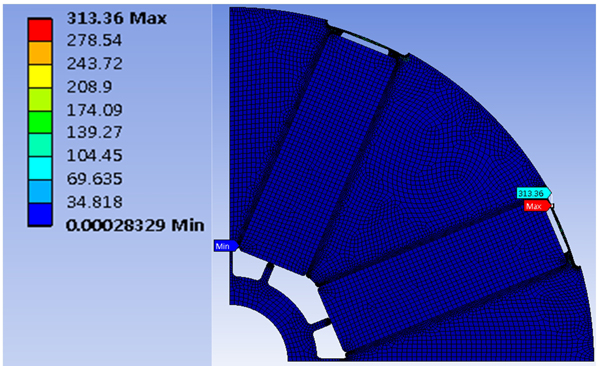 ) and the safe factor is 1.49.
) and the safe factor is 1.49.
 |
Fig. (6) Torque at 8584 rpm with optimized slit shape. |
 |
Fig. (7) Result of stiffness analysis at 8584 rpm with the optimized slit shape. |
3.3. Re-Design of the Rotor with Notch Shape and Analysis of the Torque
In the 3.2 session, we optimized the width and length of the slit shape and the torque improved by 15.2% compared to the base model. As a final shape, additional torque enhancement was carried out by adding a notch shape to the optimized slit shape. The inner length of notch shape was fixed at 1 mm to optimize the width of notch shape. Fig. (8a ) shows the torque along the changes of the notch shape width.
) shows the torque along the changes of the notch shape width.
 |
Fig. (8) Torque at 3480 rpm by various width and inner length of notch shape. |
A constant torque of 1.29 Nm at 3480 rpm was obtained with the notch shape width of 0.1 mm to 0.5 mm. However, when the notch shape width is 0.6 mm, the torque increases to 1.30 Nm at 3480 rpm and saturates. The reason for the increase in torque at the notch shape width of 0.6 mm is that the area of the outer rib related to the q-axis inductance decreases as shown in Table 4. When the notch shape width is 0.6 mm, the inductance difference is found to be between the d-axis and q-axis, which generates the reluctance torque, and the reluctance torque decreases according to Eq. (2). In contrast to the reluctance torque phenomenon, the magnetic torque is analyzed to be relatively larger than the reluctance torque as the air gap magnetic flux linkage increases.
 |
(2) |
Where P is the number of magnetic poles, ψa is the linkage flux by the permanent magnets, id is the current of d-axis, iq is the current of q-axis, Ld is the inductance of d-axis, and Lq is the inductance of q-axis.
Therefore, the notch shape width of 0.6 mm is the optimal value, and torque is analyzed through various outer lengths of the notch shape in the next step. In Section 3.2, when the slit shape length is 7 mm or more, the magnetic resistance is increased affecting the flow of magnetic flux transmitted to the air-gap and the torque decreased. In a similar trend, when the outer length of the notch shape is simulated from 0 mm to 0.5 mm, the change in torque is not apparent, so the notch shape outer length of 0 mm is determined. For the next step, Fig. (8b ) shows the result of optimizing the inner length of the notch shape with the optimized width and outer length of the notch shape. When the inner length of the notch shape is 0.5 mm, the torque is 1.30 Nm at 3480 rpm and saturated. The torque on the dehydrating mode is 0.80 Nm at 8584 rpm and the back-EMF is satisfied as 160.7 V.
) shows the result of optimizing the inner length of the notch shape with the optimized width and outer length of the notch shape. When the inner length of the notch shape is 0.5 mm, the torque is 1.30 Nm at 3480 rpm and saturated. The torque on the dehydrating mode is 0.80 Nm at 8584 rpm and the back-EMF is satisfied as 160.7 V.
Fig. (9 ) shows the final model with the optimized slit and notch shape. Comparision of torque between the basic and final model is shown in Fig. (10
) shows the final model with the optimized slit and notch shape. Comparision of torque between the basic and final model is shown in Fig. (10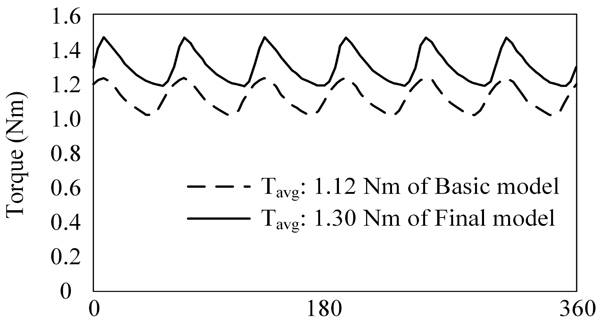 ). The torque improved 16% from 1.12 Nm to 1.30 Nm. The result of stiffness analysis at 8584 rpm, the dehydrating mode of the final model is shown in Fig. (11
). The torque improved 16% from 1.12 Nm to 1.30 Nm. The result of stiffness analysis at 8584 rpm, the dehydrating mode of the final model is shown in Fig. (11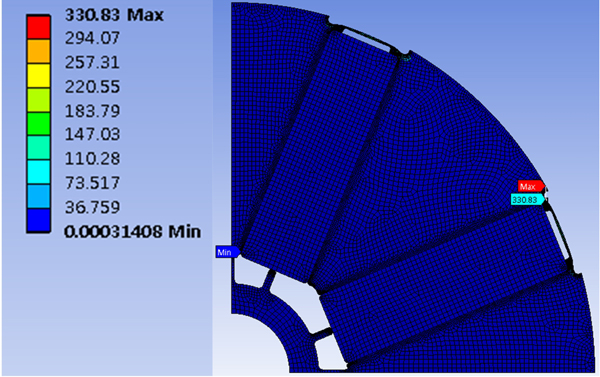 ). As a result of the stiffness analysis of the final model, the actual stress is 330.83 MPa and the safety factor is 1.4, satisfying the requirement of 1.3.
). As a result of the stiffness analysis of the final model, the actual stress is 330.83 MPa and the safety factor is 1.4, satisfying the requirement of 1.3.
 |
Fig. (9) Final optimized model of spoke-type PMSM for a washing machine. |
 |
Fig. (10) Torque of final model compared with the basic model. |
 |
Fig. (11) Result of stiffness analysis of the final model. |
3.4. Decreasing Stack Length for the Requirement of the Spoke-Type PMSM for a Washing Machine
In Sections 3.2 and 3.3, the shape of slit and notch were optimized and the torque increases to 1.30 Nm at 3480 rpm, which is increased to16% as compared to the basic model. In order to enhance the power density, it is necessary to reduce the stack length of the final model to meet the output requirements of the motor for a washing machine. Reducing the stack length can improve the power density and save manufacturing costs. The required torque of the washing machine motor is 1.12 Nm at 3480 rpm and 0.80 Nm at 8584 rpm, as shown in Table 2. Fig. (12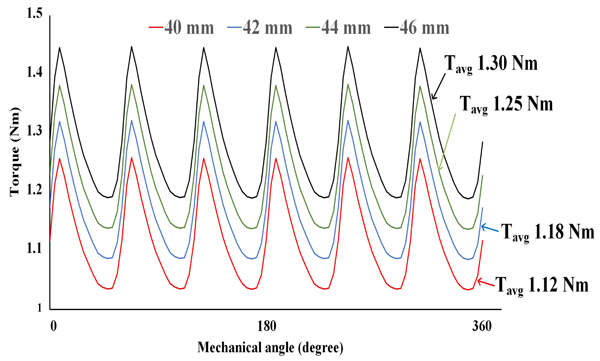 ) represents the torque analysis by varying the stack length to obtain the the required torque.
) represents the torque analysis by varying the stack length to obtain the the required torque.
 |
Fig. (12) Torque of Final model at 3480 rpm by various stack length. |
The spoke-type PMSM generates the magnetic torque and the reluctance torque. When the stack length reduces, the torque decreases linearly as follows [19J.N. Bae, " Permanent magnet synchronous machine design through an automatic selection of the specific loadings", Ph.D. Thesis, . Hanyang University, Seoul, South Korea, 2010.];
 |
(3) |
Where Kw is the winding factor, Bg1 is the fundamental wave magnitude of air-gap magnetic flux density, ac is the electric loading, Dg is the diameter of air gap, Lstk is the stack length, Ga1 is fundamental wave magnitude of relative air-gap permeance.
The final stack length satisfying the required output of the spoke-type PMSM for a washing machine is 40 mm, which is 6 mm smaller than the basic model. The output characteristics of the basic model and the final model is shown in Table 5. The power density of the final model on the washing mode was improved by 15% and the efficiency by 0.7% compared with the basic model. The power density on the dehydration mode was improved by 14.5% and the efficiency was improved by 0.2%.
CONCLUSION
In this study, 2-D finite elements analysis was performed to reduce magnetic flux leakage and to improve the torque by applying the novel shape of the slit and notch to outer rib portion of the rotor. With the optimized slit shape and notch shape, the stack length reduces for the requirement of the output characteristic for a washing machine motor and the power density improved. The redesigned rotor shape improved the torque by 16% by applying a slit shape and notch shape to the outer rib portion. In addition, the power density is improved by 15% by optimizing the stack length to match the required output of the washing machine motor.
For further research, the novel rotor shape obtained through this study would be actually manufactured and the output will be verified by performing actual tests.
CONSENT FOR PUBLICATION
Not applicable.
CONFLICT OF INTEREST
This work was supported in part by the National Research Foundation of Korea grant through the Korea Government (Ministry of Science, ICT & Future Planning) under Grant NRF-2016R1A2A1A05005392 and in part by the Korea Agency for Infrastructure Technology Advancement from the Ministry of Land, Infrastructure and Transport, Republic of Korea, under Grant 18TBIP-C143153-01.
ACKNOWLEDGEMENTS
Declared none.
REFERENCES
| [1] | W. Zhao, T.A. Lipo, and B. Kwon, "Torque pulsation minimization in spoke-type interior permanent magnet motors with skewing and sinusoidal permanent magnet configurations", IEEE Trans. Magn., vol. 51, no. 11, p. 8110804. [http://dx.doi.org/10.1109/TMAG.2015.2442977] |
| [2] | K.Y. Hwang, J.H. Jo, and B.I. Kwon, "A study on optimal pole design of spoke-type IPMSM with concentrated winding for reducing the torque ripple by experiment design method", IEEE Trans. Magn., vol. 45, no. 10, pp. 4712-4715. [http://dx.doi.org/10.1109/TMAG.2009.2022645] |
| [3] | H. Tachibana, M. Sanada, S. Morimoto, and Y. Inoue, "Study on the ratio of outer diameter to stack length suitable for high torque and high power in IPMSMs", 2012 15th International Conference on Electrical Machines and Systems (ICEMS),. Sapporo, Japan, 2012. |
| [4] | S. Cho, H. Ahn, H.C. Liu, H. Hong, J. Lee, and S. Go, "Analysis of inductance according to the applied current in spoke-type PMSM and suggestion of driving mode", IEEE Trans. Magn., vol. 53, no. 6, p. 8202404. [http://dx.doi.org/10.1109/TMAG.2017.2662719] |
| [5] | P. Liang, F. Chai, Y. Li, and Y. Pei, "Analytical prediction of magnetic field distribution in spoke-type permanent-magnet synchronous machines accounting for bridge saturation and magnet shape", IEEE Trans. Ind. Electron, vol. 64, no. 5, pp. 3479-3488. |
| [6] | W. Fei, B. Xia, and J. Shen, "Design of spoke-type ferrite interior permanent magnet synchronous machines considering the number of rotor poles", 2017 20th International Conference on Electrical Machines and Systems (ICEMS), .Sydney, NSW, Australia |
| [7] | H. Jun, J. Lee, G. Yoon, and J. Lee, "Optimal design of the PMSM retaining plate with 3-D barrier structure and eddy-current loss-reduction effect", IEEE Trans. Ind. Electron., vol. 65, no. 2, pp. 1808-1818. [http://dx.doi.org/10.1109/TIE.2017.2736501] |
| [8] | R.T. Ugale, and B.N. Chaudhari, "Rotor configurations for improved starting and synchronous performance of line start permanent-magnet synchronous motor", IEEE Trans. Ind. Electron., vol. 64, no. 1, pp. 138-148. [http://dx.doi.org/10.1109/TIE.2016.2606587] |
| [9] | R.N. Firdaus, R. Suhairi, S. Farina, K.A. Karim, and Z. Ibrahim, "Improvement of power density spoke type permanent magnet generator", 2015 IEEE 11th International Conference on Power Electronics and Drive Systems, .Sydney, NSW, Australia |
| [10] | M. Kimiabeigi, J.D. Widmer, R. Long, Y. Gao, J. Goss, R. Martin, T. Lisle, J.M. Vizan, A. Michaelides, and B.C. Mecrow, "On selection of rotor support material for a ferrite magnet spoke-type traction motor", IEEE Trans. Ind. Appl., vol. 52, no. 3, pp. 2224-2233. [http://dx.doi.org/10.1109/TIA.2016.2530722] |
| [11] | H. Seol, T. Jeong, H. Jun, J. Lee, and D. Kang, "Design of 3-times magnetizer and rotor of spoke-type PMSM considering post-assembly magnetization", IEEE Trans. Magn., vol. 53, no. 11, p. 8208005. [http://dx.doi.org/10.1109/TMAG.2017.2707593] |
| [12] | S. Lee, J. Lee, and W. Kim, "A study on correcting the nonlinearity between stack length and back electromotive force in spoke type ferrite magnet motors", IEEE Trans. Magn., vol. 53, no. 6, p. 8201404. [http://dx.doi.org/10.1109/TMAG.2017.2655059] |
| [13] | M.M. Rahman, K. Kim, and J. Hur, "Design and optimization of neodymium-free spoke-type motor with segmented wing-shaped PM", IEEE Trans. Magn., vol. 50, no. 2, p. 7021404. [http://dx.doi.org/10.1109/TMAG.2013.2282151] |
| [14] | A. Tap, L. Xheladini, T. Asan, M. Imeryuz, M. Yilmaz, and L.T. Ergene, "Effects of the rotor design parameters on the torque production of a PMaSynRM for washing machine applications", 2017 International Conference on Optimization of Electrical and Electronic Equipment (OPTIM) & 2017 Intl Aegean Conference on Electrical Machines and Power Electronics (ACEMP), . Brasov, Romania, 2017. |
| [15] | H. Nak, M.O. Gulbahce, M. Gokasan, and A.F. Ergenc, "Performance investigation of extended Kalman filter based observer for PMSM using in washing machine applications", 2015 9th International Conference on Electrical and Electronics Engineering (ELECO), .Bursa, Turkey |
| [16] | X. Liu, H. Chen, J. Zhao, and A. Belahcen, "Research on the performances and parameters of interior PMSM used for electric vehicles", IEEE Trans. Ind. Electron., vol. 63, no. 6, pp. 3533-3545. [http://dx.doi.org/10.1109/TIE.2016.2524415] |
| [17] | H. Kim, and J. Moon, "Improved rotor structures for increasing flux per pole of permanent magnet synchronous motor", IET Electr. Power Appl., vol. 12, no. 3, pp. 415-422. [http://dx.doi.org/10.1049/iet-epa.2017.0432] |
| [18] | X. Ge, Z.Q. Zhu, J. Li, and J. Chen, "A spoke-type IPM machine with novel alternate airspace barriers and reduction of unipolar leakage flux by step-staggered rotor", IEEE Trans. Ind. Appl., vol. 52, no. 6, pp. 4789-4797. [http://dx.doi.org/10.1109/TIA.2016.2600649] |
| [19] | J.N. Bae, " Permanent magnet synchronous machine design through an automatic selection of the specific loadings", Ph.D. Thesis, . Hanyang University, Seoul, South Korea, 2010. |





